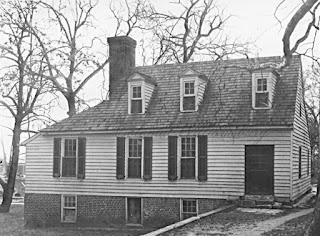Center of a medallion/frame quilt in the collection of
Colonial Williamsburg
"The center of the quilt is filled with an embroidered cornucopia and flowers appliqued with buttonhole stitches."https://emuseum.history.org/objects/28870/appliqued-pieced-and-embroidered-quilt
Circa 1790
Attributed to Mary Inglish Galt (1742-1778) or
Mary W. Taylor Galt, (ca. 1761-1813)
The central focus with squares inside other squares
is surrounded by a field of patchwork cut from chintzes.
(I color corrected the photo that was a little pink.)
The border ends with a rope-like stripe entwined with flowers cut so the rope provides a strong frame.
It's one piece of fabric with floral trail and rope,
mitered corner.
"This quilt descended in one of the most notable families of Williamsburg....
Family history attributes the quilt to Mary Inglish Galt, 1742-1778, first wife of James Galt of Williamsburg. It is more likely that the quilt was created by Mary W. Taylor Galt, (ca. 1761-1813), the second wife of James Galt."The Galts are well-documented in Colonial Williamsburg, a family of silversmiths and physicians. James Galt (1741-1800) like his father Samuel worked in gold and silver but he became the "gaoler" in the town, in charge of the local prison. In the 1770s he was hired as keeper at the Public Hospital ("part jail/part infirmary") in Williamsburg, which became an innovative place for people with mental illness.
The hospital in 1850
That hospital stands in replica in Colonial Williamsburg today. The first building with its additions burned in 1885 and when the city restoration as a Colonial history museum took place in the early 20th century the hospital was rebuilt "along the lines" of the building as it had been before the Revolution.
A large complex of galleries and meeting rooms is underground
at the hospital building today.
James Galt married twice to women named Mary. With the first wife Mary Inglish he had four children; with the second Mary Taylor he fathered eleven children. Mary Inglish died at 36 in 1778; Mary Taylor lived to be 62 dying in 1813. James died in 1800 at about 59 leaving the second Mary a pregnant widow of about 40 with 14 children of various ages (she had two sets of twins). Find-a-Grave lists three: Alexander, age 7 when his father died, Sarah 5 and Gabriel 2.
The hospital a few years before it burned in 1885
The genealogy is quite complex. Here's a book that will tell you all about those Galts. Many of them were physicians; they were in charge of the hospital into the mid 19th century.
We do not learn much about the Marys who are thought to have made this quilt, except for the references to James's wife Mary as being the matron at the hospital. This may have been the first Mary Inglish in the 1770s before her 1778 death or the second after her marriage---but it probably refers to both. In addition to raising all those children they were responsible for doing or overseeing the cooking, meals, bedding and cleaning at the hospital.
In 1826 another Mary Galt was making $400 a year as
Matron at the hospital
The Galts lived in a cottage built on the hospital grounds (and moved at least twice since then.)
Galt house as it appeared when restoration was begun in the 1920s. "The house seems to have originally consisted of a 16 x 20 foot unit.... with lean-to additions."
Inner border seems to be a strip picturing a chintz vase framed on either side
with a geometric stripe.
How this extravagant quilt fit into the framework of the Galt's lives is confusing.
As the catalog says:
"That Mary [Taylor] found the time and energy to stitch such an intricate and lovely quilt is remarkable."
"That Mary [Taylor] found the time and energy to stitch such an intricate and lovely quilt is remarkable."
A date of 1790 seems reasonable. Perhaps Mary Taylor Galt had time and assets to make it before her marriage to the keeper of the asylum. But attributing this quilt to a Virginian in the Galts' circumstances seems far-fetched. We only believe this is true because we firmly believe that American women stitched quilts as hobby needlework or to keep their families warm. The more austere the circumstances the more likely patchwork quilts were to be made is the assumption.
The Galt family's attribution of this quilt to Mary Inglish, matron at the hospital before her death in 1778 is undoubtedly based on this notion. But if we look at the object with no preconceived notions as to where it came from we would have to say that it looks British in its abundance of Indiennes, (imported Indian-style florals) and in it's central cornucopia filled with chintz appliqued florals.
Very much like a block sold at Christies in London
a few years ago
and added to Cora Ginsburg's inventory.
And similar to cornucopia details in British frame quilts pictured by English quilt historian Averil Colby as a style found on the Isle of Wight.
These cornucopia are later, perhaps 1820s & 30s, stitched with conventional applique as well
as cut-out chintz.
The quilt also looks like evidence of wealth. As Gloria Seaman Allen established in her 1985 Uncoverings paper for AQSG a quilt in 1790 (and particularly a quilt like this) was linked to the owner's wealth.
How might the Galt family have come to hand down this quilt that seems so far above their circumstances? One of the many Marys might have purchased it---as the years went by the Galt children became doctors at the hospital rather than the warden. Perhaps a matron received it as a gift from a grateful inmate. Did she save it from an inmate's estate or did she confiscate it from a hospital bed because she realized its worth?
We cannot know, but we can guess it was not made by either of James Galt's Williamsburg wives.
Mary Taylor Galt's grave:
http://quilt1812warandpiecing.blogspot.com/2012/10/style-unconfined-applique.html





















No comments:
Post a Comment
Note: Only a member of this blog may post a comment.